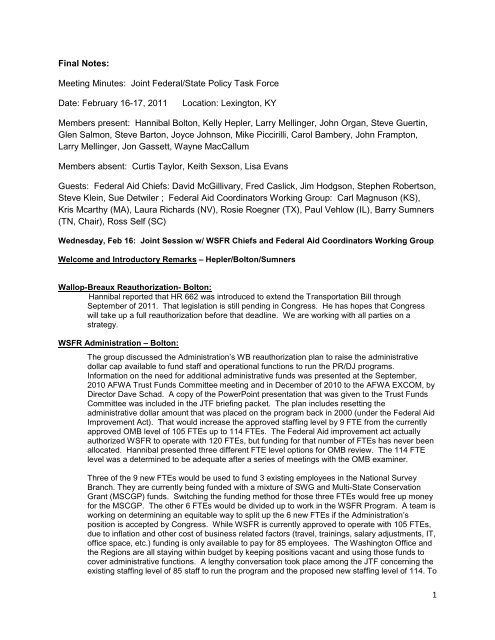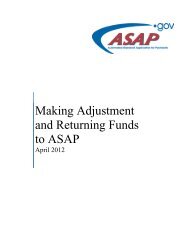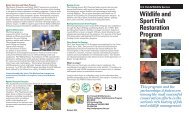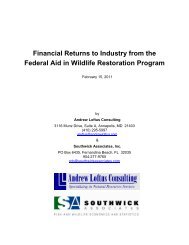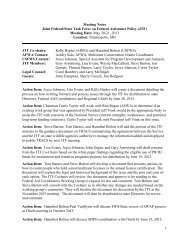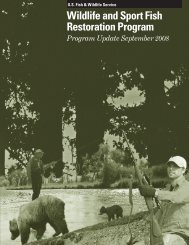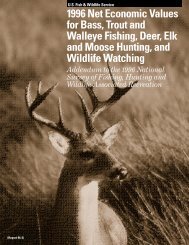February 16-17 - Wildlife & Sport Fish Restoration Program
February 16-17 - Wildlife & Sport Fish Restoration Program
February 16-17 - Wildlife & Sport Fish Restoration Program
You also want an ePaper? Increase the reach of your titles
YUMPU automatically turns print PDFs into web optimized ePapers that Google loves.
Final Notes:<br />
Meeting Minutes: Joint Federal/State Policy Task Force<br />
Date: <strong>February</strong> <strong>16</strong>-<strong>17</strong>, 2011<br />
Location: Lexington, KY<br />
Members present: Hannibal Bolton, Kelly Hepler, Larry Mellinger, John Organ, Steve Guertin,<br />
Glen Salmon, Steve Barton, Joyce Johnson, Mike Piccirilli, Carol Bambery, John Frampton,<br />
Larry Mellinger, Jon Gassett, Wayne MacCallum<br />
Members absent: Curtis Taylor, Keith Sexson, Lisa Evans<br />
Guests: Federal Aid Chiefs: David McGillivary, Fred Caslick, Jim Hodgson, Stephen Robertson,<br />
Steve Klein, Sue Detwiler ; Federal Aid Coordinators Working Group: Carl Magnuson (KS),<br />
Kris Mcarthy (MA), Laura Richards (NV), Rosie Roegner (TX), Paul Vehlow (IL), Barry Sumners<br />
(TN, Chair), Ross Self (SC)<br />
Wednesday, Feb <strong>16</strong>: Joint Session w/ WSFR Chiefs and Federal Aid Coordinators Working Group<br />
Welcome and Introductory Remarks – Hepler/Bolton/Sumners<br />
Wallop-Breaux Reauthorization- Bolton:<br />
Hannibal reported that HR 662 was introduced to extend the Transportation Bill through<br />
September of 2011. That legislation is still pending in Congress. He has hopes that Congress<br />
will take up a full reauthorization before that deadline. We are working with all parties on a<br />
strategy.<br />
WSFR Administration – Bolton:<br />
The group discussed the Administration’s WB reauthorization plan to raise the administrative<br />
dollar cap available to fund staff and operational functions to run the PR/DJ programs.<br />
Information on the need for additional administrative funds was presented at the September,<br />
2010 AFWA Trust Funds Committee meeting and in December of 2010 to the AFWA EXCOM, by<br />
Director Dave Schad. A copy of the PowerPoint presentation that was given to the Trust Funds<br />
Committee was included in the JTF briefing packet. The plan includes resetting the<br />
administrative dollar amount that was placed on the program back in 2000 (under the Federal Aid<br />
Improvement Act). That would increase the approved staffing level by 9 FTE from the currently<br />
approved OMB level of 105 FTEs up to 114 FTEs. The Federal Aid improvement act actually<br />
authorized WSFR to operate with 120 FTEs, but funding for that number of FTEs has never been<br />
allocated. Hannibal presented three different FTE level options for OMB review. The 114 FTE<br />
level was a determined to be adequate after a series of meetings with the OMB examiner.<br />
Three of the 9 new FTEs would be used to fund 3 existing employees in the National Survey<br />
Branch. They are currently being funded with a mixture of SWG and Multi-State Conservation<br />
Grant (MSCGP) funds. Switching the funding method for those three FTEs would free up money<br />
for the MSCGP. The other 6 FTEs would be divided up to work in the WSFR <strong>Program</strong>. A team is<br />
working on determining an equitable way to split up the 6 new FTEs if the Administration’s<br />
position is accepted by Congress. While WSFR is currently approved to operate with 105 FTEs,<br />
due to inflation and other cost of business related factors (travel, trainings, salary adjustments, IT,<br />
office space, etc.) funding is only available to pay for 85 employees. The Washington Office and<br />
the Regions are all staying within budget by keeping positions vacant and using those funds to<br />
cover administrative functions. A lengthy conversation took place among the JTF concerning the<br />
existing staffing level of 85 staff to run the program and the proposed new staffing level of 114. To<br />
1
e supportive of the proposal the State JTF members requested additional detail. Hannibal<br />
agreed that additional clarification was needed to be transparent and said he would get additional<br />
information out to the JTF as soon as possible.<br />
Status of 50 CFR 80 –<br />
Tom Barnes reported that the WSFR Branch of Policy is working on the 50 CFR 80 Final Rule.<br />
He intends to move it forward for approval by the Director, the Department of the Interior, and<br />
OMB no later than mid-April.<br />
Discussion of any upcoming issues of concern to States, Regions, AFWA, FWS,<br />
WSFR and JTF -- Bolton/Hepler/All<br />
• Barry and several FAC members would like to see a positive message come out from WSFR<br />
in regards to the transition to FBMS. Action: Hannibal agreed to investigate this.<br />
• The blackout period for transition to FBMS concerns the States and they would like WSFR to<br />
investigate how States could draw a percentage of their funds ahead of the blackout period to<br />
fund programs and staff. Action: Hannibal will see if we have the legal authority to do<br />
this.<br />
• States continue to struggle to match federal funds. Using program income as state match<br />
continues to be something that the States would like WSFR to look into and clarify. State are<br />
looking for any other sources that might be available to help match PR/DJ funds. Larry got<br />
everyone’s interest by explained that in some cases, Natural Resource Damage Account<br />
(NRDA) funds can be used as state match. This is a complicated area involving policy,<br />
regulations and law, but worth pursuing. Action: a legal opinion will be needed on the use<br />
of NRDA funds as match. Larry will investigate. A document that outlines allowable ways<br />
to match federal funds was discussed.<br />
• Additional <strong>Program</strong> Income information: Note from Glen- After I sent out the original notes<br />
from this meeting, several JTF members commented that my notes were incomplete, and<br />
that more information on this topic was needed. As a follow up, I requested additional<br />
thoughts and comments. At the end of these notes, under Additional program Income<br />
information, I have included what JTF members sent me.<br />
• Glen asked about how the “bump” in PR was used. Several Coordinators and FA Chiefs<br />
reported on how the funds were used to just hold existing programs together, or in some<br />
cases do new work such as purchasing land. He would like to see a one-pager created to<br />
demonstrate to partners how those funds were used by the States. Action: this will be<br />
discussed at the AFWA Trust Funds Committee<br />
• Hannibal briefed the JTF on the decision by DOI Secretary Salazar to move the Coastal<br />
Impact Assistance <strong>Program</strong> (CIAP) from the Bureau of Ocean Energy Management,<br />
Regulation and Enforcement (BOEMRE) to the FWS, under WSFR. The CIAP program<br />
involves six states that produce offshore oil and gas (AL, AK, TX, LA, CA, MS). This transfer<br />
will be complete on October 1, 2011. A joint BOEMRE/FWS team is working on the transition<br />
documents and process.<br />
Information on the CIAP program is available on the BOEMRE website:<br />
http://www.boemre.gov/offshore/CIAPmain.htm<br />
75th anniversary of WSFR :<br />
Glen briefed the JTF of progress on the 75 th anniversary of the WSFR program. A State/Federal<br />
/NGO steering committee has been formed and several working groups are tasked with<br />
communications, funding, and events. The kick-off is planned for the 2012 North American<br />
meeting. Christina Zarrella is working full time on the project. A symbol (aka logo) has been<br />
2
adopted by the committee as well as the tag line: 75 years of success, a partnership for<br />
America’s fish and wildlife. The next meeting will be at the March 2011 NA meeting<br />
The Council to Advance Hunting and the Shooting <strong>Sport</strong>s :<br />
Carol reported on the progress of the group. A search for a CEO is underway. An ad in the Wall<br />
Street Journal and other outreach resulted in 45 candidates, of which the search committee plans<br />
to interview 8-10. CAHSS has a 28 member board of directors and about $2 M in operating funds<br />
contributed by the States through a WSFR grant process from the bump in PR funds. The focus<br />
of the group will be to pursue a national strategy to effectively recruit and retain hunters and<br />
shooters. The next meeting will be at the March 2011 NA meeting.<br />
Integrating LCCs and State Management/Conservation Needs:<br />
State and FWS members reported on the progress of standing up LCCs, and the underlying issue<br />
of States needing funds to participate. The group discussed that it appeared that much was<br />
being accomplished, but a means to tell the success stories was needed. Kelly indicated that<br />
perhaps Doug Austen might be the key to start getting the word out. No JTF action item was<br />
identified.<br />
Thursday, <strong>February</strong> <strong>17</strong>, Joint Task Force only session.<br />
Summary of topics brought forward from the Joint Session and continued JTF<br />
involvement with Regional Chiefs and States - Hepler/Bolton<br />
Hannibal led a discussion on the upcoming transfer of WSFR grant fiscal functions to FBMS and<br />
where the FWS is with developing an accomplishment reporting system (TRACS) to replace<br />
FAIMS. FAIMS has been scheduled to be shut down on numerous occasions in the past, but it is<br />
still surviving on life support. The latest FAIMS decommissioning date was to be October 1,<br />
2011, but Hannibal and staff have continued to work with the FBMS folks to be sure that no<br />
WSFR reporting functionality is lost. Several of the critical components of FAIMS such as safety<br />
margins and apportionment calculations will not be supported by FBMS and will eventually<br />
become a component of the new TRACS system. The fiscal and financial management<br />
components all must go under the FBMS system. Time is needed to get the new system up and<br />
running. FAIMS will be extended for at least 6 months and perhaps a year past the October 1,<br />
2011 deadline. Several JTF members asked about the process to involve the States on the<br />
TRACS development. Hannibal explained that a State Project Advisory Group has been<br />
involved with the development of TRACS since the beginning. Action: Send out the PAG<br />
membership to the JTF. The JTF had additional discussion about data security and access<br />
and the need to protect sensitive information.<br />
Action items from September, 2010 JTF meeting:<br />
1) The Trust Funds Committee will discuss the potential loss to WSFR income due to the Gulf Oil<br />
Spill and the potential to quantify this dollar amount and seek reimbursement. The TFC will charge<br />
AFWA’s legal committee to define ways in which claims could be filed and action could be taken.<br />
Action taken: This topic was discussed at the TFC in September 2010. Consensus of the TFC<br />
was that it would be very difficult to make the legal case to recover any funds based on decrease<br />
in license sales. No additional action was required.<br />
2) Name 4 State Representatives to the “Council Technical Advisory Working Group”<br />
3
Action taken: None at this time, the Council is not ready at this time to submit potential projects<br />
for review. Representative will be named by November 2011.<br />
3) Draft a white paper in response to the following comment on the proposed draft of 50 CFR 80:<br />
(Should recruitment of hunters be eligible for funding under Enhanced Hunter Education because<br />
it is not explicitly authorized in the Pittman-Robertson <strong>Wildlife</strong> <strong>Restoration</strong> Act?)<br />
Action taken: Discussed at this JTF meeting- see notes below.<br />
4) Review of the Boating Access Provisions of the <strong>Sport</strong> <strong>Fish</strong> <strong>Restoration</strong> <strong>Program</strong><br />
Action taken: An invitation was made to Doug Hobbs and the <strong>Sport</strong> <strong>Fish</strong>ing and Boating<br />
Partnership Council to attend the next JTF meeting. They made a presentation at this JTF<br />
meeting. See notes below.<br />
5) JTF will review and assess the need to revisit appropriate chapters within the lands and<br />
administrative policy chapters relative to program income.<br />
Action taken: Tom Barnes reported that he is currently working on the Administrative and Lands<br />
Chapters and will look at this issue by the end of the calendar year.<br />
6) The JTF has agreed to reconvene in Lexington, Kentucky<br />
Action taken: Did that.<br />
Status of the recommendation to update JTF Charter :<br />
Carol passed out the final draft of the Draft charter for review and comments. No substantial issues were<br />
raised. Action: the charter will move to Hannibal to seek FWS Director’s signature.<br />
Including a “free” sport fishing license with hunting licenses :<br />
The topic was raised in reaction to information that some states had either recently adjusted their license<br />
structure to provide a free fishing license with an already established hunting license, or were about to<br />
offer such a license. JTF State directors members were concerned that this appeared to simply be a<br />
means to “game the system” to increase the number of certified anglers in those States and hence collect<br />
additional DJ funds. The “level playing field” approach and consistent application of the WSFR program<br />
rules and regulations are important keystones of the JTF process. A lengthy discussion took place on<br />
this topic. Larry pointed out that the current regulations are clear and that the license certification process<br />
is restricted to only counting a license if an actual sale of the license occurs which returns $1 to the State.<br />
In the case under discussion, no additional fee for the new license (above the already existing license<br />
fee) was charged, and hence the license should not be counted as a license sold.<br />
Action: A white paper will be prepared and this discussion will continue at the Trust Funds Committee in<br />
March, 2011. Additionally, the FA Chiefs will determine if other States are involved in this type of activity.<br />
Organ, Frampton, Barnes, Salmon and Mellinger are charged with development of the white paper.<br />
Eligibility of hunter and angler equipment exchange programs :<br />
A white paper covering this topic was provided in the JTF briefing folder. A small group consisting of<br />
Lisa, Gassett, Wayne, Frampton, Dave and Steve worked on this issue.<br />
Action: The JTF indicated that they agree that these are eligible as long as the actual project is<br />
determined to meet the substantial in character and design requirement.<br />
-<br />
<strong>Sport</strong> <strong>Fish</strong>ing and Boating Partnership Council:<br />
Doug Boyd, Vice Chair and SOBA President James Adams gave an excellent PowerPoint presentation<br />
on the activities of the SF&BPC. A good open discussion took place of a variety of topics including<br />
increased possibilities to match federal funds, access issues, interpretation of regulations covering launch<br />
4
facilities for small boats and problems with communicating past JTF and WSFR decisions down to the<br />
program manager level. This was the first time that SF&BPC had addressed the JTF. The two groups<br />
pledged to continue to working closed together in the future.<br />
Action: WSFR staff will reach out to Doug Hobbs and Gary Armstrong, who was on the review<br />
committee to frame up the issues to be addressed.<br />
Issue: The WSFR tool kit is hard to find for our partners-can it be made more visible?<br />
Action: Glen will work with our web-site staff<br />
Issue: The 15% requirement for motorboat access funds continues to be a struggle for some States to<br />
meet. Could a 5 year rolling average be used instead?<br />
Action: discuss at TFC in March to determine if the States are interested in pursuing this as an option.<br />
Action: Kelly and Hannibal- draft a note back to the SF&BPC thanking them for attending and briefing<br />
the JTF.<br />
Boating-related Regulation revisions - 50 CFR Part 86 (BIG) and Part 85 (CVA):<br />
Tom Barnes provided a written update, which was included in the JTF briefing packet. New regulations<br />
will strive to take into account the 30 recommendations of the SF&BPC to improve overall management,<br />
execution and participation.<br />
Discussion of Action Item # 3 from September 2010 JTF meeting: Should recruitment of hunters be<br />
eligible for funding under Enhanced Hunter Education because it is not explicitly authorized in the<br />
Pittman-Robertson <strong>Wildlife</strong> <strong>Restoration</strong> Act?<br />
A white paper authored by Tom McCoy (FWS) and Lisa Evans was distributed for review. Lisa was on<br />
the phone from Alaska for this conversation. Lisa said that several States had approached her recently<br />
and were still unclear as to what types of PR (sec 4A, section 10, regular WR) money was considered<br />
acceptable to use in hunter and shooter recruitment programs. Her information was that some grant<br />
applications had been questioned by the Regions. The JTF had a good discussion but was not ready to<br />
issue guidance at this time. Additional information seemed to be needed.<br />
Action: John Organ and Lisa Evans will reach out to the Chiefs and Coordinators to determine why grant<br />
proposals have not been approved. This information will be used to assess whether there is<br />
inconsistency among regions in terms of what R&R activities are deemed eligible, or if the grant<br />
proposals were questioned for other reasons. Once this information is assessed, recommendations for<br />
JTF action will be made.<br />
Additional JTF comments on <strong>Program</strong> Income:<br />
From Barry Sumner's notes on the issue<br />
Using <strong>Program</strong> income as match:.<br />
<strong>Program</strong> income is usually accounted for using the deductive method; occasionally<br />
the additive method is allowed; and the rules also include the matching method. We<br />
discussed this with the Chiefs and asked whether using program income for match is<br />
ever allowed. They stated that it has been used on rare occasions in the past and<br />
will only be allowed in extreme circumstances. An example would be a catastrophic<br />
event that makes it impossible for an agency to complete a federal project without<br />
using <strong>Program</strong> Income as match.<br />
Thoughts from Mike Piccirilli:<br />
I think it's important to remember that the JTF attachment and the revised 50 CFR 123, soon to be final<br />
have almost identical language.<br />
5
Also when <strong>Program</strong> Income is used as match I view it as actually changing the state/federal match to<br />
94% federal and 6 % state although it's not displayed to that detail on the SF-424. <strong>Program</strong> Income is<br />
generally earned at the typical grant match ratio of 75% to 25% . When program income ($250,000) is<br />
used as match on a $1 Million grant, the Federal $ actually is $937,500. $750,000 of apportioned funds<br />
and 75% of the $250,000 of program income being used as match. This is a slippery slope and I think<br />
does nothing but encourage states to develop grants for producing revenue which is prohibited.<br />
Thoughts from John Organ:<br />
Some states want greater flexibility in using <strong>Program</strong> Income as match - the cost sharing approach.<br />
Traditionally only Additive and Deductive methods were allowed, but the JTF saw that 43 CFR Part 12<br />
also allowed cost sharing, so made it eligible. The JTF did not consider the reasons for why cost sharing<br />
has not been allowed, and to be fair, it isn't carved into stone anywhere, it is more implicit in the program<br />
regs and law. Using grant funds to generate income is expressly prohibited, so allowing program income,<br />
which should be incidental to accomplishing grant objectives, to be used as match turns into a slippery<br />
slope. Also, the intent of congress was for this to be a cooperative program with states sharing the cost -<br />
not a 100% federally funded program (see legislative history). The cost share method was designed for<br />
programs that are having difficulty achieving equitable representation across society. An example would<br />
be grant programs for day care or health care facilities where there is little incentive to develop these<br />
programs in under-privileged areas. Using program income as match helps (incentifies) achieving<br />
broader application and access. That has never been an issue with WSFR because all states receive<br />
funds. The Chief’s policy has been to only allow program income as match under extraordinary<br />
circumstances such as Katrina where license revenues may decline precipitously as a result of natural<br />
disasters. I've attached a guidance document we drafted in region 5 and circulated to the WO and<br />
Chiefs. Ord Bargerstock (from the DC office) had the lead on the issue at the time.<br />
Here is the guidance document John referred to:<br />
<strong>Program</strong> Income<br />
Guidance for Application of Cost-Share Method to Federal Assistance Grants<br />
Director’s Order <strong>16</strong>8, <strong>Program</strong> Income from Federal Assistance Grants, was signed by the Director on<br />
March 11, 2004. Prior to issuance of DO <strong>16</strong>8, guidance for program income on Federal Assistance<br />
grants was contained in Appendix II of the Federal Aid Manual, Guidelines for <strong>Program</strong> Income.<br />
Appendix II guidelines mandated that disposition of program income must be done either by the additive<br />
or deductive methods. Common rule regulations (43 CFR Part 12.65) provide for a third disposition<br />
method: cost sharing. DO <strong>16</strong>8 departs from the Appendix II guidance by allowing use of the cost share<br />
method under certain circumstances deemed appropriate by the <strong>Fish</strong> and <strong>Wildlife</strong> Service. The Service<br />
must make the final decision on allowability of the cost share method based on a variety of factors related<br />
to the intent of the <strong>Wildlife</strong> and <strong>Sport</strong> <strong>Fish</strong> <strong>Restoration</strong> <strong>Program</strong>s.<br />
Background<br />
The cost share method was designed to provide incentives to encourage participation by underrepresented<br />
groups or communities in existing programs. For example, a grant program may experience<br />
difficulty in delivery because potential grantees may not be willing to assume risks in providing services in<br />
certain sectors. The cost share method would provide incentive by allowing grantees to use income<br />
under the grant to defray required matching share. Confusion in current guidance is the result of<br />
seemingly conflicting guidance in financial management rules and PR/DJ program rules. Guidance under<br />
43 CFR 12.65 explicitly states “Grantees are encouraged to earn income to defray program costs.”<br />
6
<strong>Program</strong> rules (50 CFR 80.14c) specifically prohibit using <strong>Wildlife</strong> and <strong>Sport</strong> <strong>Fish</strong> <strong>Restoration</strong> funds to<br />
generate additional revenue, unless incidental to accomplishment of grant objectives.<br />
Congress, as clearly indicated in the legislative history of the <strong>Program</strong>, intended for States and the federal<br />
government to each contribute financial resources in a truly cooperative effort. Senator Key Pittman<br />
stated the following in hearings leading up to passage of the Pittman-Robertson <strong>Wildlife</strong> <strong>Restoration</strong> Act:<br />
“The State and Federal Government will jointly pay the cost of these wildlife restoration projects.”<br />
[Congressional Record July 6, 1937]<br />
“The plan is to utilize the fund raised from the tax upon guns, shells, ammunition, in connection<br />
with a fund raised in the States from the issuance of licenses for hunting and fishing.” [Congressional<br />
Record August 7, 1937]<br />
These inherent conflicts, and the fact that <strong>Wildlife</strong> and <strong>Sport</strong> <strong>Fish</strong> <strong>Restoration</strong> has full representation and<br />
participation, were the reasons why cost share had not previously been allowed for Federal Assistance<br />
grants.<br />
Joint Federal/State Task Force Guidance<br />
The JTF, in a memorandum dated December 12, 2003 transmitting DO <strong>16</strong>8 to the Service Director and<br />
AFWA Executive Vice President, noted that the new policy would allow use of the cost share method<br />
“only when the Service deems appropriate based on appropriate considerations, as described in the<br />
recommendation. The JTF notes that the regulations provide for considerable flexibility, and that this is<br />
very much a statement of policy.” Examples of acceptable factors where income incidental to<br />
accomplishment of grant objectives could be disposed of using the cost share method were developed by<br />
the JTF:<br />
(1) Allow the State share of funds to be used on additional fish or wildlife related projects that<br />
otherwise could not be sufficiently funded;<br />
(2) Allow State’s Federal Assistance funds saved by using this method to be targeted for<br />
additional qualified <strong>Program</strong> activities; or<br />
(3) Results in a net benefit to the <strong>Program</strong>.<br />
Appropriate Application of Cost Share Method<br />
As specified in DO <strong>16</strong>8 and the JTF memorandum, the cost share method should only be applied for<br />
disposal of program income under certain circumstances deemed appropriate by the Service based on<br />
appropriate considerations. A paramount consideration is whether application of the cost share method<br />
would violate the intent and integrity of the <strong>Program</strong> through the purposeful generation of income or by<br />
essentially funding a project with 100% federal funds. Circumstances where cost share method could be<br />
applied, if consistent with the above considerations, include:<br />
• State is in serious financial difficulty due to catastrophic events that significantly reduce ability to<br />
generate matching funds.<br />
• State in risk of reversion due to unusual circumstances not related to internal <strong>Program</strong><br />
management.<br />
• Federal share of project is minimal.<br />
• Changes in federal policy that affect a State’s ability to generate matching funds in short-term.<br />
7
Schedule for upcoming JTF meetings: – Bolton/Hepler<br />
The location fo the next meeting will be in the San Francisco area in August of 2011. Date<br />
selected were:<br />
Travel day Monday, August 15 th ; meeting days on Tuesday the <strong>16</strong> th and the morning of<br />
Wednesday the <strong>17</strong> th ; travel home on the evening of the <strong>17</strong> th or the 18 th .<br />
8


